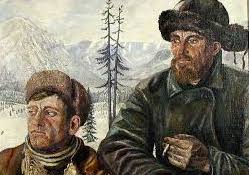
1904 - 1967
Mikhail Tsybasov

description
A Russian painter and graphic artist, book illustrator and film artist. Mikhail Tsybasov was among the followers of Pavel Filonov, who formed the core of the group “Masters of Analytical Art” and remained faithful to his teacher until the end, despite the persecution that he was subjected to by the Soviet government.
In his work, the artist strictly followed the basic principles of the system of analytical art. Hardworking and purposeful Tsybasov did everything masterfully. His hard work and professionalism allowed him to master the “principle of accomplishment”, which was fundamental for representatives of analytical art.
Mikhail Tsybasov actively participated in the collective work of Filonov’s students on the design of costumes and sets for the production of “The Inspector General”, thanks to which the group’s work became widely known. In 1931, he became one of the most prominent developers of illustrations of the Finnish ethnic epic “Kalevala”, investing a lot of strength and energy in this publication. Eight large illustrations for the poem became one of the best graphic works of the artist and in many respects formed his graphic style, determining the theme and manner of his subsequent work.
In the last years of his life, the artist focused mainly on portraits, where he fully expressed his bright and positive attitude towards people and life.
Key ideas:
– The artist was a loyal follower of the Filonov School, recognizing it as “the only real school of art.” He reworked the analytical method of his teacher in accordance with his own artistic vision and preferences. Unlike Filonov, the analysis of the object was not the main task for Tsybasov. The artist only strove to achieve the maximum artistic expressiveness of his works with its help, to make them real and “alive”.
– A distinctive feature of Tsybasov’s creative method was his attention to detail, careful consideration and elaboration of all the details of the work. In accordance with the “principle of completeness”, the artist used the dot as the smallest pictorial unit, covering every millimeter of paper or canvas. Thanks to this, Tsybasov achieved a fantastic unity of form and content in his works.
– Contemporaries of the artist always noted his positive attitude towards the world, sincerity and openness. These features are reflected in the work of Mikhail Tsybasov, which conveys a joyful attitude, admiration for the perfection of nature and his genuine interest in folk life.
– In parallel with the work on illustrations and orders in monumental painting, Tsybasov created numerous portraits. Most often, the artist depicted his family, relatives, friends and himself.
– During his long creative career, the artist painted at least twelve self-portraits, as well as portraits of his friends and their families. In each portrait by Tsybasov’s, his sincere interest in the inner world of man, his hopes and aspirations are noticeable. Most portraits are made in a style close to realism.
1904
1924
1926
1927
1931
1932
1935
1941
1950
1967
Mikhail Tsybasov was born
The young man entered the Art and Industrial College at the Academy of Arts

The artist joined the association “Masters of Analytical Art”

“The Inspector”

“Kalevala”

"Artists of the RSFSR in 15 years"

Tsybasov was expelled from the Union of Artists for "formalism"

Joined the ranks of the Soviet army

He painted many portraits

The death of the artist

